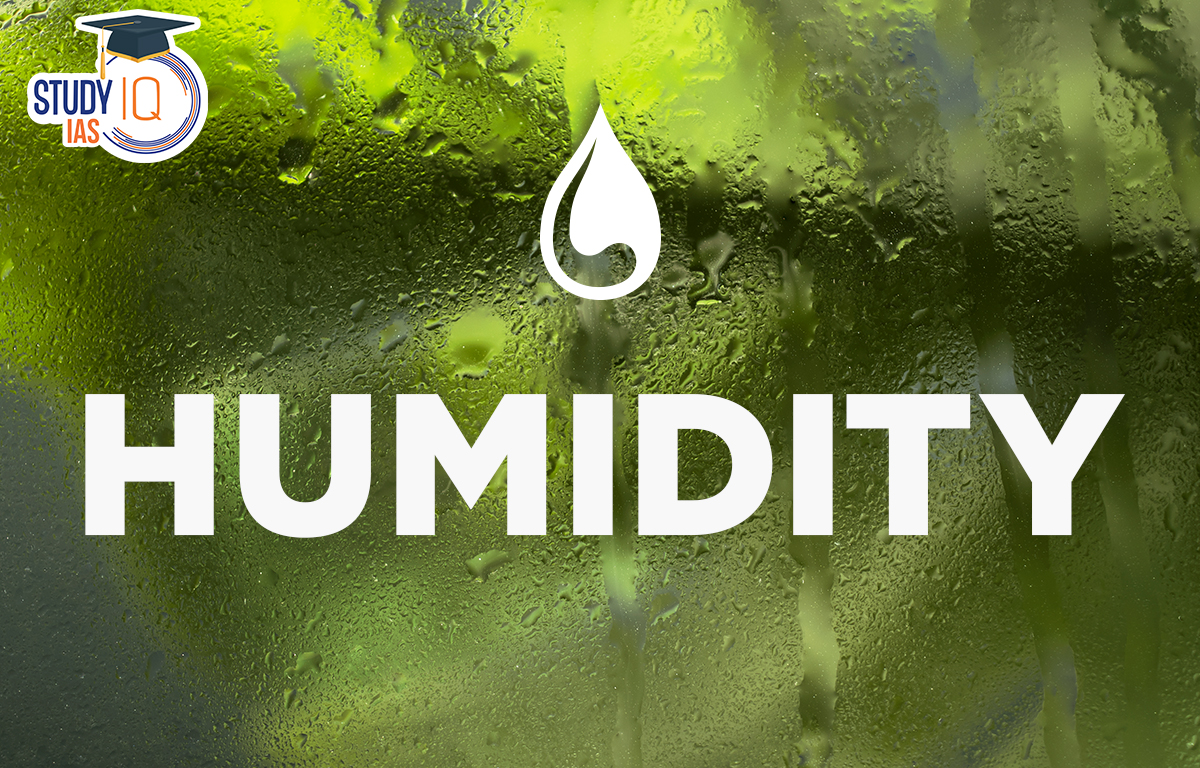Table of Contents
Humidity
Humidity is the measure of the amount of airborne water vapour. The amount of water vapour in the air is measured as humidity. Absolute, relative, and specific humidity are the three most common types of humidity measurements. The humidity reading reveals how much moisture or water vapour is present in the air. The humid index essentially informs us how much moisture is in the air.
Temperature affects how much water vapour is present in the air as a humidor. As a result, the rate of humidity or moisture likewise rises in tandem with the rise in temperature. In addition, there are two basic mechanisms that produce humidity ie evaporation, and Transpiration. Let’s learn more about the three main methods for measuring humidity in this article.
Read More: Evaporation and Condensation
Humidity Types
Humidity is expressed quantitatively in three ways i.e., Absolute Humidity, Specific Humidity and Relative Humidity.
1. Absolute Humidity
In a unit volume of air, it is the weight of the actual amount of water vapour that is present. Generally, it is expressed in grams per cubic meter of air. The absolute humidity varies from place to place and from time to time. It decreases from the equator towards the poles.
In general, changes in air pressure or temperature result in variations in absolute humidity. However, if the temperature increases but there is no excess water for evaporation, absolute humidity will not change.
2. Specific Humidity
The specific humidity is the weight of the actual amount of water vapour present in a unit weight of air. In most cases, it is stated in grammes per kilogramme of air.
Read More: Air Masses
3. Relative Humidity
The ratio of the atmospheric moisture content to its maximum capacity at a given temperature is relative humidity. The Relative Humidity is expressed in percentages.
Generally, the capacity to hold water vapour increases with an increase in temperature and decreases with a decrease in temperature. Thus, the relative humidity of the air decreases as the temperature rises and vice versa. The equatorial region has the highest relative humidity. Relative humidity gradually decreases towards the Tropical high-pressure belts (between 25°—35° latitudes). After this, the relative humidity again increases polewards. The relative humidity is maximum in the mornings and minimum in the evenings. Evaporation decreases when there is high relative humidity and vice versa.
The relative humidity is directly related to human health. That is why the equatorial region with high temperatures and relative humidity and the hot tropical deserts with very low relative humidity are unfavourable for human health.
Read More: Fronts
Humidity Measurement
A device known as a hygrometer can be used to determine the relative humidity of a location. One dry bulb thermometer and one wet bulb thermometer make up a psychrometer, which is a hygrometer. The humidity is determined by the difference between the two values.
Read More:
Humidity Effects
The water vapour content controls the amount of Rainfall during extremely strong downpours, in which all of the water in the atmosphere is frequently soaked out. We are more likely to experience rain when the humidity is higher because water vapour expands at a faster rate. Below are the effects of Humidity on weather, plants and animals etc.
1. On Weather
- It aids in the development of clouds and light Precipitation.
- Tropical storms and even hurricanes can develop as a result of high humidity levels.
- Additionally, it aids Southeast Asian nations during the monsoon’s tremendous downpours.
Read More: Types of Clouds
2. Plants and Animals
The relative humidity determines which species of animals and plants can flourish in a certain area. Sweat is unable to evaporate when the air is very damp. Our bodies feel heated and sticky as a result. In these circumstances, profuse sweating enhanced blood circulation, and respiration control body temperature.
3. Electronics
Electronics are made to function at specified humidity levels. High humidity can cause permeable insulators to conduct more readily, which can lead to failure. Materials become brittle with low humidity. No matter the declared humidity range, condensation poses a serious risk to electronic devices. Condensation covers circuit boards and other insulators when an electronic device is transferred from a cold environment, like a garage, to a humid environment, like a home, short-circuiting the device. Low humidity encourages the accumulation of static electricity, which causes computers to shut down when the discharge takes place.
4. Industry
The capability of chemical factories that utilise furnaces as part of specific processes is negatively impacted by high humidity.
Read More: Tropical Cyclone
Difference Between Absolute Humidity & Relative Humidity
| Absolute Humidity | Relative Humidity |
| Actual water vapour content in a unit volume of air, measured in weight | percentage of the atmosphere’s moisture content that is present relative to its maximum amount. |
| Expressed in grams per cubic meter of air | Expressed in percentages. |
| Independent of temperature | Decreases with an increase in temperature and vice versa. |
| It remains relatively constant, | Subjected to changes in water vapour. |
| Determines the amount of precipitation. | Tells us about the possibility of rainfall |
Read More: Pressure Belts
Humidity UPSC
The amount of vapour or gaseous water molecules in the air at any particular time is measured as humidity. Both relative and absolute humidity measurements are possible. We discuss the fundamental concept of humidity in this article which is beneficial for the UPSC exam.


 Story of Meera Bai and Her Devotion For ...
Story of Meera Bai and Her Devotion For ...
 Desert Climate, Distribution, Climatic C...
Desert Climate, Distribution, Climatic C...
 Deserts of India Map, Features of Thar D...
Deserts of India Map, Features of Thar D...





















